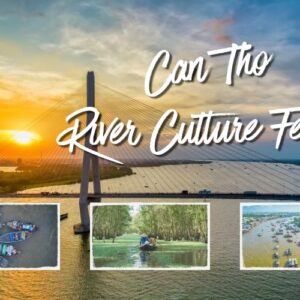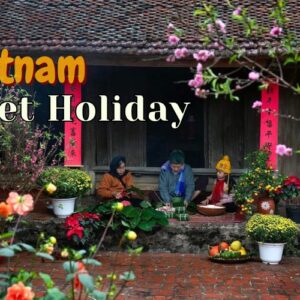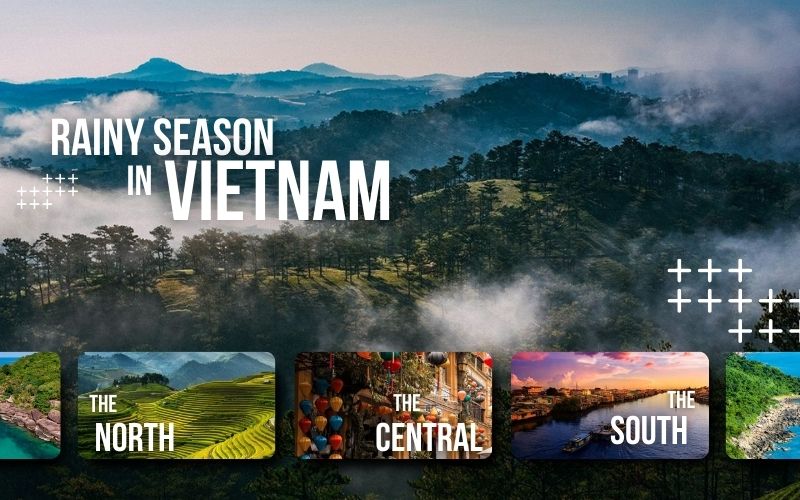
The rainy season is typically considered the wrong time to take a trip, but it can also be the best time to kick off a new one, when rain cleans the air and unveils stunning natural landscapes, particularly in a nation whose landscapes are unique, like Vietnam.
Overview on rainy season in Vietnam
Vietnam climate with its high temps and high humidity is categorized into two seasons: the wet season and the dry season. The rainy season in Vietnam actually begins and ends on a schedule and features certain weather patterns. However, since the country has a long S-shape geographically, there are differences in the time, rain amount and temperature during rainy season.
The average temperature fluctuates between 21 to 35 degrees depending on the area, high humidity in the atmosphere, with heavy rain in the rainy season. Although the rain sometimes disrupts the lives of those living in the area, they are the same elements that elevate nature in Vietnam and contributed in making it more diverse.
Many people question whether it is possible to travel to Vietnam during the rainy season. The reality is, that there are benefits to this time of year: Lower costs for flights, fewer tourists, and the place looks beautiful. If you plan your dates and locations wisely, you can have an amazing trip during the rainy season in Vietnam.
Rainy season by region
A lot of people ask whether it is recommended to travel to Vietnam during the rainy season and often compare it to when is the best time to visit Vietnam in the dry season. In reality, both seasons have their own attractive features and benefits depending on your requirements.

Temperature and rainiest months in 3 regions in Vietnam’s rainy season
Northern region
April to October is rainy season in Northern Vietnam, June to August are rainy season at it’s peak, with average temperature generally between 25 and 30 degrees Celsius, humidity is extremely high and can lead to periods of rainfall over numerous days in a row at peak time.
Because of this persistent heavy rainfall during July and August, typical rainy season in Vietnam, Northern mountainous areas could suffer landslides while low-lying areas could have floods.
Yet, there is a distinct aspect of Northern Vietnam, a typical seasonal beauty. The terraced fields of the pouring water season, the green mountains and forests, the cool air and the high, blue sky. If you are organized you will experience a totally different Northern Vietnam, peaceful, vibrant and alive.
Central region
In the Central region, the rainy season typically begins in September and lasts until December, a few months later than in the North. Storms and tropical depressions that produce heavy, protracted rains are the hallmarks of this season. During the rainy season, provinces like Hue, Da Nang, and Quang Nam are frequently the ones most impacted by storms.
Although the weather is somewhat harsh, the rainy season is also the time when the Central region puts on its own unique beauty. Because rain increases the number of living things, this is thought to be the best time to enjoy the Central region’s rich cuisine.
Southern region
The southern part of country experiences its rainiest months from June to August. The rain season generally begins from May and runs until November. The best time to go out and visit is when the temperatures are not too hot between 25 and 33 degrees. Likewise, you are still able to carry out tourist activities because the rains that come in during June, July and August are pretty much just short showers that come in the evening.
This is the perfect time for floating tourism with rich cuisine. Because the rain comes and goes swiftly and has minimal effect on the schedule, Rainy season in Vietnam is more tourist-friendly than in the North and Central areas. The wet season is the best time to really explore the South whether you enjoy Mekong Delta food, the bustle of the Cai Rang and Cai Be floating markets, or the expansive natural riverscape.
>>> For a more comprehensive view of Vietnam’s diverse climate, and how the country transforms away from the rainy season, consider taking a look at Vietnam in Winter for greater details on the weather and how it affects travel.
Why Should you Choose to Travel in Rainy Season?
Many people are still hesitant to consider whether traveling in the rainy season in Vietnam is the right choice or not. Although heavy rain can cause inconveniences for the trip, when looking at it on a more positive note, it is the perfect time for those who love the quiet or want to explore the original beauty of nature and also because they can save quite a bit of money for the journey. Here are the reasons why you should consider packing your bags and starting your journey to Vietnam in the rainy season.
Service prices are cheaper than in the peak time
One of the most valuable reasons is that traveling in the rainy season helps you save a significant amount of money. Compared to airfares, hotel room prices and tourism services in the peak season of tourism, which is the dry season, these factors often decrease sharply in the rainy season. Many resorts, homestays all have time to launch attractive promotional programs to stimulate demand. This means you can experience the same services at a much cheaper price than during peak season.
Less crowded, quieter experience
While high season tends to make beaches, tourist attractions and streets full of tourist, in the opposite, rainy season also gives you tranquility and much more space. You can stroll casually on tree-lined streets, visit historical sites or simply sip a cup of coffee in a small shop in a charming alley, without the disturbance of noisy crowds.
Rich cuisine
On rainy days, the cool weather tends to make our taste buds crave hot dishes and spicy foods even more than usual – just a steaming bowl of beef noodle soup, a rich seafood hot pot, or a bowl of hot fish porridge will warm us from the inside out.
During the rainy season, there are a rich variety of seasonal specialties in the Central region and the regions to the South: the Mekong Delta has its flood season with fish mud carp, lotus flowers, water mimosa, etc., which can be processed as sour soup, braised or stir-fried with a good flavor. The Central region is becoming cold, and the cold and wet days are very suitable for hot and flavorful dishes such as Quang noodles, snakehead fish noodle soup, fish or jelly fish hot pots and a range of hot Hue cakes.
With the source of fresh, “in season” ingredients and the method of cooking that is warming – spicy – rich, rainy season food is especially attractive, both tasty and having a charm of locality that is hard to forget.
>>> In addition to the “warm – spicy – rich” dishes when it rains, check out Top 9 Must-Try Summer Dishes in Vietnam to plan your culinary when the sun shines.
Unique Sceneries to Discover in Rainy Season in Vietnam
During the rainy season in Vietnam, steer clear of the peak months of landslides, typhoons, or floods. Generally, that means July–August (North mountain tribes) and October–November (Central coast) and peak flood weeks in the Mekong Delta (around September – October). With careful planning and checking Vietnam weather by month, you can actually find the right window to enjoy calm, scenic landscapes with fewer tourists around.
Outside of these spikes and with the state advisories checked, many places are terrific, calm, and great to take photos!
Terraced fields in the North
Highland districts, such as Sapa, Y Ty, and Mu Cang Chai have terraced crops that can now receive water from the season’s first rain. All fields are now reflecting the sky as a gigantic mirror which produces a more original picture than before. The rain has worked as a medicine for the trees, and the hills are now covered in green yeasts like a carpet.
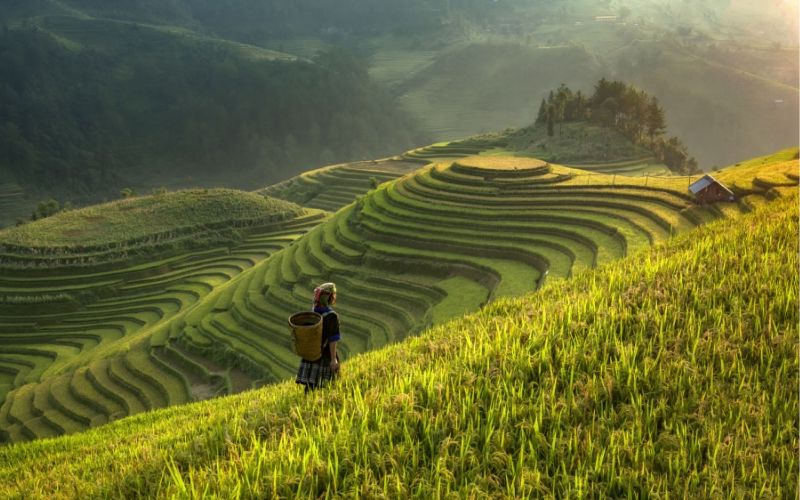
Mu Cang Chai – Vietnam
Romantic rain in the Central
Compared to the busy atmosphere of the bright lights of Hoi An ancient town or the antique walls of the ancient capital of Hue in the dry season with sunlight blaring down on you, this quiet, poetic beauty of this land in the rainy season is hidden away in the light dripping rain, the gentle sunset on the Huong River. By choosing the central region as the destination this season, you feel as if you are lost in a vivid ink painting.

Hue and Hoi An – Vietnam
Mekong Delta in the South
Coming to the West during the flood season, you will feel the distinct change of nature. The water from the big rivers is rising, turning the fields into vast seas of water, creating conditions for aquatic species to thrive. This is also the time when you can experience the floating market, row down to the Tra Su cajuput forest and enjoy rustic dishes that are only available this season, prepared by the locals themselves.
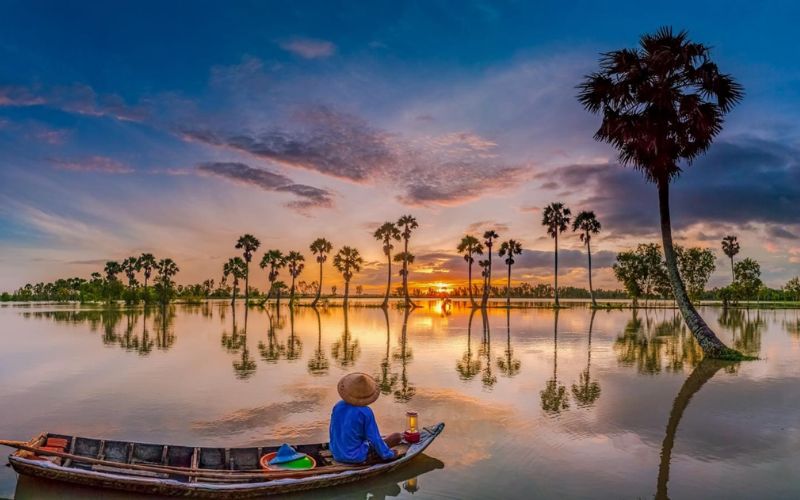
Mekong Delta – Vietnam
>>> If you want to get even closer to the Delta‘s labyrinth of canals, why not take an private cruise on the Song Xanh Sampan – a traditional sampan that customizes your morning for the Cai Rang floating market, particularly stunning during the flood season when waterways are at their picturesque best.
In addition to the 3 prominent places above, there are many other beautiful destinations in the rainy season that you can refer to such as:
- In the North
- Ninh Binh (Trang An, Tam Coc): green mountains and rivers after rain.
- Cao Bang (Ban Gioc waterfall): water flow strong, most beautiful at around 8-9
- Bac Son (Lang Son): rice valley ripe at late 9-early 10, foggy after rain.
- Moc Chau / Mai Chau: tea hills, foggy villages; scenery lovely “green” after rain.
- Ba Be (Bac Kan): lake surface calm, green humid forests; nice waterfall after misty rain.
- Tam Dao: cloud hunting, cool climate
- In Central region & Central Highlands
- Phong Nha – Ke Bang: Son river is blue after a few days of rain
- Da Nang: city break convenient (museum, cafe, night bridge)
- Quy Nhon/ Phu Yen: mostly empty bays – rocky rapids
- Ninh Thuan (Phan Rang – Vinh Hy): dry area, little rain all year round
- Da Lat: 5-8 magnificent waterfalls (Pongour, Datanla)
- Buon Ma Thuot (Lak lake, Dray Nur): highland forests are very green after the rain.
- Tam Giang lagoon (Hue): beautiful sunset reflection on the water with light rain.
- In the South & Mekong Delta
- Ho Chi Minh City: visit museums, markets, cafes
- Can Tho (Cai Rang), Ben Tre, Vinh Long: after rain usually produces green canals, floating market is best in the early morning.
- Tra Vinh / Soc Trang: Khmer pagodas are brilliant! Amazing photos with humid skies.
- Tay Ninh (Ba Den Mountain): quick showers usually provides good views after rain.
- Can Gio: mangrove forests, boat trips to ecosystem
- Phu Quoc: primeval forest and Suoi Tranh great rainy season
Travel tips in the Rainy Season in Vietnam
Wet travel can strike worry in many people, but if you plan in advance and you know how to enjoy it, you are likely to have a time better than you expect! Here are some travel tips I’ve learned from traveling all over Vietnam that will be helpful to you.
Prepare specialized items
Raincoat, foldable umbrella, non-slip shoes
Don’t underestimate sudden rains. The first time our group went to Hoi An in October, everyone subjectively did not bring a raincoat because they thought “it’s just a light rain”. So, we had to go to a nearby store, buy a plastic raincoat to wear temporarily. The lesson learned is to always have a light raincoat or a folded umbrella in the corner of the backpack. If you like to walk to leisurely enjoy the scenery, you should prepare a pair of non-slip shoes. When I was in Pongour Da Lat, I wished I had prepared a pair of trekking shoes when trying to move on the rocks at the waterfall.
Waterproof bag for electronic devices
Another time, I was leisurely taking photos of one of the World Heritage sites of Vietnam – Imperial Citadel of Thang Long in the drizzling rain when a heavy rain suddenly poured down, my phone was soaked in water, I had to take it to get it repaired immediately, luckily I didn’t lose any photos or videos. So the lesson learned is to always have a waterproof bag on hand, otherwise you have to use a zip bag but bring many to replace when needed.
Flexible schedule
Two years ago, I decided to visit the Mekong Delta region. My plan to visit the floating market early in the morning was spoiled by the rain. Instead of canceling the trip, I rescheduled it for about midday and was pleasantly delighted to see a river with sparkling water which was stunning. Even though I arrived when the market was practically closed, it was an unforgettable experience. If you can’t go to the beach, try our indoor activities like learning to cook local dishes, visiting a spa, or simply sitting and drinking little cups of coffee at an odd roadside shop.
Safety comes first
Do not cross mountain passes in the rain. If heading to the mountains in the North of Vietnam (Ha Giang or Sapa) ask a legitimate local travel company for advice or send a request and ask about weather and road conditions. Alternate activities At the beach, when there are advisories from local officials against swimming in the water, even if the weather is just a little bit rainy, do other activities.
Safe means of transport
In prolonged rainy weather, the train is the safest choice because the railway is less affected than the road. If you have to travel by car through the mountain pass, rent a car with a driver who knows the road instead of driving yourself when you are not a skilled driver and are not used to the rain and wind.
Rainy season in Vietnam may not be the best time to visit Vietnam upon initial observation, but when you truly understand Vietnam climate and how it shapes the landscapes, you’ll realize it is one of the most rewarding time to explore this land. With the foggy mountains of the North, Centre’s timid lover’s rain and the South’s enthralling waterways, Vietnam is an incredible work of living art that’s characterized by fresh green lush and tender loveliness. Instead of waiting for sunshine, give us a call to ride out the rain and discover a new, real Vietnam.
Read more:

